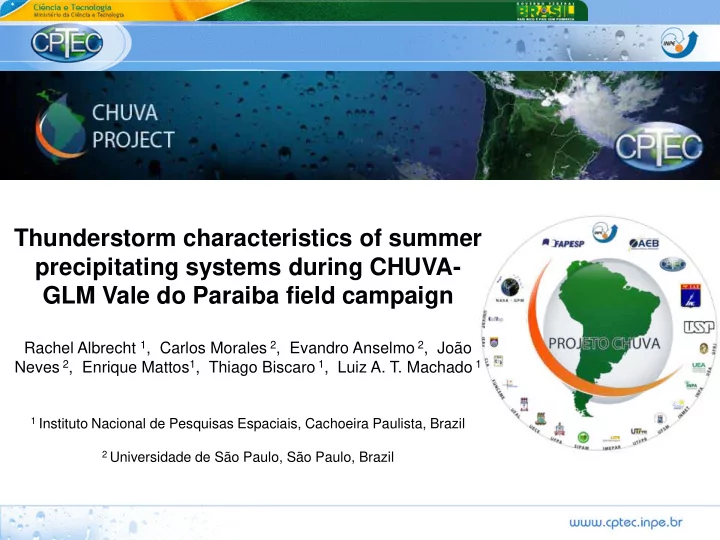

Thunderstorm characteristics of summer precipitating systems during CHUVA- GLM Vale do Paraiba field campaign Rachel Albrecht 1 , Carlos Morales 2 , Evandro Anselmo 2 , João Neves 2 , Enrique Mattos 1 , Thiago Biscaro 1 , Luiz A. T. Machado 1 6 1 Instituto Nacional de Pesquisas Espaciais, Cachoeira Paulista, Brazil 2 Universidade de São Paulo, São Paulo, Brazil
Thunderstorm characteristics of summer precipitating systems during CHUVA- C loud processes of t H e main precipitation GLM Vale do Paraiba field campaign systems in Brazil: A contrib U tion to cloud Rachel Albrecht 1 , Carlos Morales 2 , Evandro Anselmo 2 , João resol V ing modeling and to the GPM (Glob A l Neves 2 , Enrique Mattos 1 , Thiago Biscaro 1 , Luiz A. T. Machado 1 6 Precipitation Measurement) 1 Instituto Nacional de Pesquisas Espaciais, Cachoeira Paulista, Brazil 2 Universidade de São Paulo, São Paulo, Brazil
CHUVA Field Campaign Schedule
4 th CHUVA field campaign: CHUVA – GLM (Geostationary Lightning Mapper) Vale do Paraíba Objectives • • Characterize the life cycle of thunderstorms in respect to their environmental, dynamical and microphysical aspects • Acquire total (intracloud and cloud-to-ground) lightning data under the coverage of MSG SEVIRI for GOES-R GLM and MTG LI pre-launch activities: • Generate GLM and LI proxy data based on ground-based lightning networks and TRMM-LIS overpasses • Use SEVIRI as proxy data for GOES-R ABI and MTG ABI • Develop tools for alert, monitoring and nowcasting using lightning and remote sensing data (multi-sensor and multi-platform) • Understand the ground based networks for GOES-R and MTG ground validation (GV) Period of observations • • Summer 2011-2012 (01-Nov-2011 to 31-Mar-2012)
CHUVA-GLM Vale do Paraíba ~250km
CHUVA-GLM Vale do Paraíba Instrumentation: • 10 Disdrometers X-band Dual-Pol mobile Radar 2 MicroRain radars (Joss-Waldgel, Thies, Parsival) 15 Rain Gauges 1 Lidar 2 Radiometers 3 Radiosonde sites … and more: Weather stations Turbulent fluxes Soil Humidity GPS humidity Solar Radiation Air quality CCN counter
CHUVA-GLM Vale do Paraíba Instrumentation / data: •
CHUVA-GLM Vale do Paraíba
CHUVA-GLM Vale do Paraíba PRELIMINAY RESULTS: • 5 months of continuous data: • Local convection due to thermodynamics • Local convection due to topography • Cold fronts • Convection from South Atlantic Convergence Zone (SACZ) • Squall Lines • Severe Weather (20+ cases of hail storms, damaging winds, flooding): • Severe Weather reports are being gathered from Civil Defense, Newspapers, TV news, Internet sources (blogs, social networking, etc.), Insurance Companies
CHUVA-GLM Vale do Paraíba PRELIMINAY RESULTS: • Case study of a severe weather event (07 January 2012): • Hail , damaging winds and flooding were reported in São Paulo and Guarulhos.
CHUVA-GLM Vale do Paraíba THUNDERSTORM STRUCTURE:
CHUVA-GLM Vale do Paraíba
CHUVA-GLM Vale do Paraíba
CHUVA-GLM Vale do Paraíba
CHUVA-GLM Vale do Paraíba
CHUVA-GLM Vale do Paraíba
CHUVA-GLM Vale do Paraíba
CHUVA-GLM Vale do Paraíba
CHUVA-GLM Vale do Paraíba
CHUVA-GLM Vale do Paraíba
CHUVA-GLM Vale do Paraíba Very rapid increase in incloud lightning activity has been associated to severe weather (tornadoes, hail and damaging winds) [ Schultz et al. 2009; Gatlin and Goodman 2010 ]
CHUVA-GLM Vale do Paraíba NEXT STEPS: • Track all convective system using ForTraCC (Vila et al., 2004) algorithm adapted for radar data: • Build a database of severe and non-severe thunderstorms with collocated lightning and remote sensing data (this database will be available at CHUVA website) • Study the relationship between total lightning and cloud updraft for severe weather monitoring, alert and nowcasting: • Verify if a lightning jump algorithm can predict severe weather in tropical convection over Brazil. Study the jump of lightning sources in the main charge centers (-15 o C and - • 25 o C) with polarimetric variables (study the cloud microphysics evolution to the electrification processes).
CHUVA WEB CHUVA data is openly available to the scientific community!!! Access our web site: http://chuvaproject.cptec.inpe.br Collaborations are very welcome!!!
Thank you for your attention!!! rachel.albrecht@cptec.inpe.br 6 http://chuvaproject.cptec.inpe.br/ Acknowledgments:
Recommend
More recommend